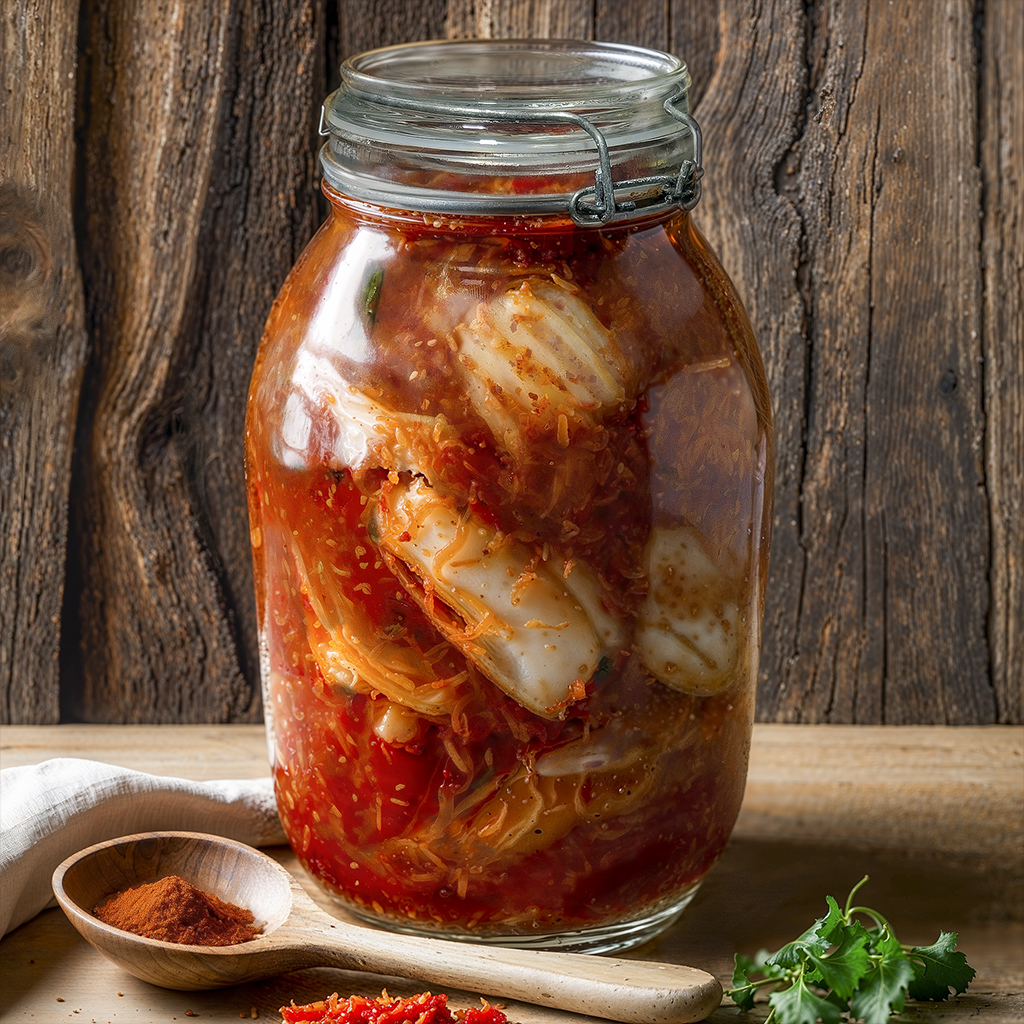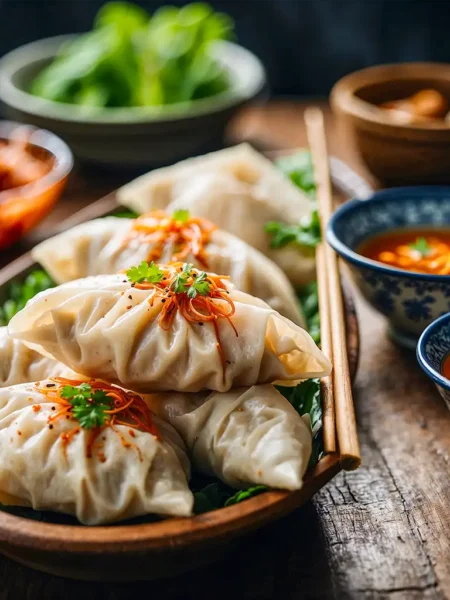Although I’ve never had the opportunity to visit Korea, I’ve always been fascinated by the culinary aspect of their culture, which seems to share a similar “philosophy” with our Polish cuisine. For example, lactic fermentation serves not only to enhance flavor but also as a traditional method of food preservation for winter. Similar to Poland, Korean cuisine is dominated by pork, with cabbage being a staple vegetable. We also share a love for intense flavors and adding fermented foods to our dishes. These similarities make me feel that after trying many Korean dishes, Poles and Koreans share similar culinary tastes and preferences.
We have our sauerkraut, while Koreans have kimchi – an icon of their cuisine known to practically everyone. It’s so characteristic and omnipresent in Korean culture that it has become a national symbol. For me, kimchi represents the “next level” of fermentation. I love how it takes on a different character each day, and the possibilities for its use are limited only by imagination – from simple sandwiches, through pancakes and stews, to my favorite mandu (dumplings).
I particularly relate to the tradition of communal kimchi preparation for winter, called “kimjang.” It evokes childhood memories when the whole family would gather to prepare preserves for winter. Today, kimchi is not only Korea’s national dish – it has also been recognized by Health magazine as one of the world’s healthiest foods, thanks to its probiotic properties and high vitamin content.
Tongbaechu-kimchi
Tongbaechu-kimchi (통배추김치), often referred to as Poggi-kimchi (포기김치), is a traditional Korean method where fermentation starts with whole Napa cabbage heads, which are typically halved or quartered during preparation. Unlike the popular mak-kimchi (막김치), where cabbage is cut into smaller pieces beforehand, fermenting the cabbage in these larger sections gives the dish an elegant character and makes it a frequent choice for special occasions.
What distinguishes tongbaechu-kimchi is the ability to control the fermentation process through the size of the cabbage heads and how they're stored. Larger heads ferment more slowly, preserving a fresh taste longer, while smaller ones develop characteristic sourness faster. Properly stored kimchi can mature for up to a year, with each stage of fermentation offering different flavor qualities that can be used in various dishes.
Ingredients
Salting the Cabbage
Rice Porridge
Vegetables
Seasonings and Additions
Instructions
Preparing the Cabbage
-
Before starting, wash your hands thoroughly and prepare a clean work surface. Carefully examine each cabbage head - remove outer, damaged, or wilted leaves. If the stems protrude too much, trim them with a sharp knife, leaving about 2-3 cm of the base.
-
Divide each cabbage into two halves. To properly split the cabbage without damaging the densely packed leaves, first make a small incision (about 3-4 cm) at the base of the stem. Insert your thumbs into the cut and gently spread it apart. Allow the cabbage to naturally split lengthwise. If you encounter resistance, you can gently deepen the incision with a knife.
-
In each half, make an incision through the stem, about 5 cm above the base. The cut should be deep enough to cut through the stem but not damage the leaves. The leaves should be loose but still firmly attached to the stem. This cut will later facilitate even salting and application of the paste.
-
Check that all leaves can be easily spread apart - this will be crucial for salting.
Salting the Cabbage
-
Prepare a large bowl or container with clean, cold water. The container should be large enough for the cabbage to be completely submerged. The water should be at room temperature.
-
Immerse the cabbage halves (one at a time) in water. Gently move the cabbage in the water so that water gets between the leaves. Remove and allow excess water to drain.
-
Begin salting. Working over a large bowl, start with the outer leaves. Gently lift each leaf and sprinkle with salt, paying special attention to the white, thicker parts. Make sure the salt is evenly distributed.
-
Set the cabbage aside for 2 hours. Every 30 minutes, gently turn each half. If brine collects at the bottom of the container, you can pour it over the upper parts of the cabbage. With each turn, check the flexibility of the leaves - they should become limp but not soft.
-
After about 2 hours, perform a test. Take a piece of the thicker part of a leaf and gently bend it. It should bend easily without breaking. If it's too stiff, it may require additional salting time.
Preparing the Rice Porridge (during cabbage salting)
-
In a small pot, combine water with rice flour. Use a wooden spoon or silicone spatula for mixing. Mix vigorously to avoid lumps forming. Initially, the mixture will be cloudy and watery.
-
Cook over medium heat, stirring constantly to avoid burning. Cook for about 10 minutes until it starts to bubble. Add sugar and cook for another minute, stirring. Remove from heat and allow to cool completely.
Preparing the Kimchi Paste
-
Finely chop garlic, ginger, and onion. Then blend everything into a smooth paste.
-
Transfer the cooled rice porridge to a large bowl. Add the blended vegetables, fish sauce, and Gochugaru pepper flakes. Mix everything with a spoon until a uniform paste forms.
-
Finally, add the chopped radish, carrot, green onions (cut into 1-2cm pieces), and chives (if using). Mix all ingredients thoroughly with the rest of the paste.
After 2 Hours of Salting
-
Take each cabbage half and rinse thoroughly under cold water. Rinse between the leaves to remove all salt. Repeat rinsing at least 3-4 times until the water runs clear. Make sure no salt crystals remain. This step is crucial for the final taste of kimchi - thorough rinsing of salt prevents excessive saltiness, and proper draining ensures the right consistency during fermentation.
-
During rinsing, take each half and find the stem incision that was made before salting. Gently separate along this cut, dividing each half into two parts.
-
Cut off the stem. Try to cut so that the leaves remain connected at the base.
-
Place the quarters in a colander or sieve. Allow water to drain freely for about 15-20 minutes. You can gently shake each quarter to get rid of excess water. Don't squeeze the cabbage.
Preparing the Kimchi
-
Put on disposable gloves (the paste is spicy and may stain hands). In a large bowl, apply the kimchi paste to each cabbage leaf. Start with the outer leaves. Apply paste between each leaf, reaching all the way to the center. Pay special attention to the areas at the base of the leaves. The paste should be spread evenly, but not too thickly.
-
When all leaves in a quarter are covered with paste, roll it into a small package and place it in a jar, plastic container, or traditional onggi vessel. Arrange the rolled quarters tightly next to each other, pressing gently to remove air bubbles. Leave about 5 cm of space from the top of the container. Kimchi will "work" during fermentation, so the liquid may overflow if we don't leave enough space.
Fermentation
-
Kimchi will begin to ferment after 1-2 days at room temperature. The speed of fermentation depends on the temperature and humidity of the room - the warmer and more humid, the faster the process. The first signs of fermentation are a slightly sour smell and the appearance of bubbles. Initially, the taste is slightly spicy and fresh.
-
Check the progress of fermentation daily. By pressing with a spoon on the surface of the kimchi, you'll see gas bubbles emerging from underneath. Check the smell and taste.
-
If using an airtight jar with a lid, remember to open it occasionally to release accumulated gases and press down on the kimchi with a spoon. Close the jar, but don't screw it too tightly.
-
After about 2-4 days, transfer to the refrigerator, where the process will continue but more slowly. The flavor will continue to develop. Over time, the kimchi will become increasingly sour.
Nutrition Facts
Serving Size 100g
- Amount Per Serving
- Calories 22.3kcal
- % Daily Value *
- Total Fat 0.4g1%
- Total Carbohydrate 4.2g2%
- Protein 1.6g4%
* Disclaimer: The provided nutritional values are estimates only. Actual calorie and nutrient content can vary significantly depending on the specific products used, exact quantities, and preparation method. Always consult with a healthcare provider for personalized dietary advice.
Notes
- You can adjust the amount of gochugaru according to your preferences - 1 cup will give a milder kimchi, 2 cups - spicier.
- Blending garlic, ginger, and onion allows for better distribution of aroma throughout the paste.
- Kimchi in its initial phase is fresh and crispy. After 1-2 weeks in the refrigerator, it develops a classic, sour taste. After 2-3 months, it becomes very sour - perfect for kimchi jjigae (soup). Of course, the best time to consume depends on individual preferences and it can even be eaten right after preparation.
- You can control the fermentation rate through storage temperature.



